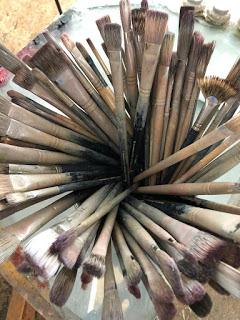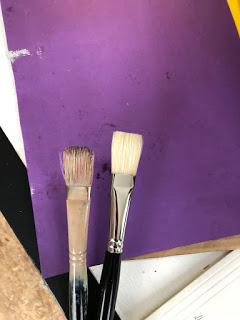
I taught a limited palette workshop over the weekend and thoroughly enjoyed myself. The painters were a keen bunch who worked hard, asked good questions and were as excited by the magical effects of hue, value and temperature as I am. My kind of people!
One thing that came up repeatedly - as it does in every workshop - was brushes.
I paint in layers, often wet-in-wet and not every bristle type is capable of doing that.
To apply the layers of heavy oil paint cleanly, one on top of the other, my brushes have to be strong and flexible; soft or floppy brushes just won't work. They won't hold enough paint or release it cleanly on top of a wet paint layer.
Most brushes meant for acrylics fall into the too-soft category when they're pressed into service for oil paint. They don't have the strength to spring back under the weight of oils and are often ruined by the cleaning solvents.
The bristles I use are the most common one among oil painters who like to work with thick paint: hog bristles. Specifically, I use Rosemary & Co Ultimate bristle and Series 2065 in flats and filberts. They're super durable and economical with a size 12 Ultimate flat costing a measly $14 CAD. I order directly from the manufacturer in the UK and my brushes arrive in Canada within 10 days for about $12 shipping. (I have no affiliation with Rosemary & Co; they just happen to make the best brushes I've found and I've tried a lot of brushes.)
Long bristles are a must for building alla prima layers because they hold so much paint and can lay it down gently without disturbing the lower paint too much. I'm particularly enjoying the Series 2065 for their extra length. They not only layer well, but also allow me to make calligraphic marks when I turn and twist them as I apply the paint.

bright shape
Though it seems to be the most popular brush shape in workshoppers' gear, the bright is useless for this type of painting. Its stiff, short bristles hold very little paint and invariably scrape into the wet lower layer instead of depositing paint on top.Along with the type of bristle, the size of the brush is very important. Small brushes hold small amounts of paint. This means that if you want to make a big area of colour, you'll have to reload frequently and are likely to end up with a patchy, mark-filled look to the painted area. Imagine trying to paint the walls of your house with a brush. The color wouldn't be the thing that you noticed when you looked at the wall, the millions of brush marks would be. So if you want to make a flat, simple patch of colour, you have to use a big brush.
Most of my work is done with size 10 or 12 brushes and on bigger paintings I use house painting brushes from the hardware store. As long as the bristles aren't too worn, big sizes are capable of a surprising amount of detail work when used on their edges. Detail by my standards, anyway.

Size 10: worn and new

Looks like detail to me!
Size 6 is the smallest size I use and it doesn't get much action in my paintings. Little brushes encourage me to become nitpicky and I'm seldom happy with what they bring to my work. Instead, I use a brush that feels uncomfortably large for the area that I want to paint. It gives my work a loose, confident look, like I don't sweat the small stuff - even when I do!
Cleaning tip: natural bristle brushes don't like water: it makes them soft and kills their springiness. So skip the soap and water step entirely. Instead, clean excess paint in a rag, then swish in solvent, wipe again, and let them dry. If you need to resurrect a stiff brush, massage an oil-based soap like Murphy's oil soap into the bristles and leave it for 24 hours. Then swish the soap out with solvent instead of water. You may need to repeat the process and not all brushes can be saved. It's ok to put synthetic brushes in water but I never bother. Life is too short to wash dishes, clothes, hair, AND brushes so I just do the first 3.
To become a good painter you need to invest in good tools. Quality brushes, professional grade paint, and quality canvas or panels will make a huge difference to your work and your enjoyment of the painting process.
Happy painting!
Link to my Artsy article about brushes for a few months ago: https://www.artsy.net/article/artsy-editorial-10-types-paintbrushes-artist
If you enjoy reading about my painting adventures and discoveries, you can receive this blog in your inbox by clicking the "subscribe" button at the top of the page. I don't do anything nefarious with your email address. Spam is another thing for which life is too short.

